
Silloth was the terminus of the Carlisle and Silloth Bay Railway, a branch railway from Carlisle, England. The town, dock and station at Silloth were built on a greenfield site after the Carlisle & Silloth Bay Railway & Dock Act (1855) was passed. The railway provision grew with the dock and its later additions.

Camerton railway station was situated next to the River Derwent on the Cockermouth and Workington Railway. It served the village of Camerton, Cumberland, England.
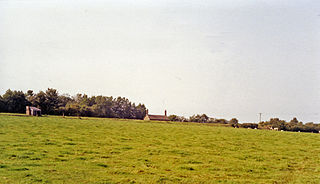
Abbey Junction railway station was the railway junction where the branch line to Silloth on the Solway Firth divided from the Solway Junction Railway in the English county of Cumberland.
There were two interlinked railways on the south shore of the Solway Firth.

Port Carlisle railway station was a railway station in Port Carlisle, Cumbria; the terminus on the Port Carlisle Railway, serving the village and old port and the steamer service to Liverpool that ran from here until 1856, when it was transferred to Silloth. Port Carlisle was two and a half miles away by train from Drumburgh and Glasson was one and a quarter miles away. The journey time to Drumburgh was nine minutes, although Glasson was a request stop.
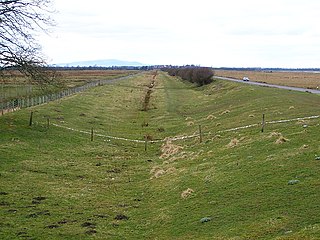
Drumburgh railway station was near the village of Drumburgh, Cumbria, England.
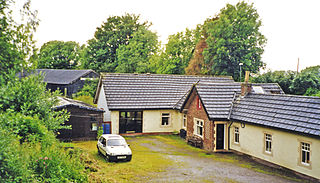
Kirkandrews railway station was near Kirkandrews-on-Eden, Cumberland, England. It was on the Port Carlisle Railway branch, and later part of the Silloth branch. The station served the village and the rural district. Kirkandrews closed on 7 September 1964; with the line to Silloth as part of the Beeching cuts.The station building survives as a private dwelling.

Brayton was a railway station which served as the interchange for the Solway Junction Railway (SJR) with the Maryport and Carlisle Railway (M&CR); it also served nearby Brayton Hall and district in Cumbria. The station was opened by the M&CR and became a junction station in 1870 on the 25 mile long SJR line.

Dearham Bridge was a railway station on the Maryport and Carlisle Railway (M&CR) serving the village and rural district of Dearham in Cumberland, England. The station was opened by the M&CR in 1842 as Dearham, but was renamed Dearham Bridge in 1867 when the M&CR opened a station in the village of Dearham, to which it gave that name. Dearham Bridge station lay in the Parish of Crosscanonby.
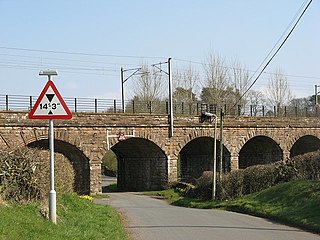
Kirtlebridge railway station was a station which served the rural area around Kirtlebridge and Eaglesfield, north of Annan in Dumfriesshire, Scotland; the location is now within the area of Dumfries and Galloway unitary council.
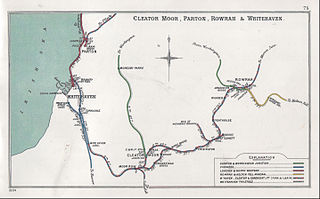
Rowrah railway station was built by the Whitehaven, Cleator and Egremont Railway. It served the village of Rowrah, Cumbria, England.

Harrington railway station, or Church Road halt, was a railway station in Harrington, Cumbria, England. It was opened by the Cleator and Workington Junction Railway (C&WJR) on the company's Harrington Branch which connected with the Lowca Light Railway at Rosehill to provide a through route from Lowca to Workington Central and beyond.

Rosehill railway station was opened by the Cleator and Workington Junction Railway (C&WJR) on the company's Harrington Branch which connected with the Lowca Light Railway (LLR) at Rosehill to provide a through route from Lowca to Workington Central and beyond.

Linefoot railway station, sometimes referred to as Linefoot Junction and sometimes as Linefoot Goods, briefly served the scattered community around the crossroads at Linefoot, near Cockermouth in Cumberland, England.

Moss Bay Cart Siding was used for two periods as a temporary northern terminus for workmen's trains to Lowca. It was situated where Moss Bay Road crossed the CWJR's Derwent Branch in southern Workington in the former county of Cumberland, England, which is now part of Cumbria.
Mealsgate railway station was in the former county of Cumberland, now Cumbria, England. It was a stop on the Bolton Loop of the Maryport and Carlisle Railway.
Allhallows Colliery railway station was in the former county of Cumberland, now Cumbria, England. It was a stop on the Bolton Loop of the Maryport and Carlisle Railway.

Cumberland and Westmorland Convalescent Institution railway station was a terminus off the short Blitterlees Branch off the Carlisle and Silloth Bay Railway, within Silloth itself. The larger railway ran from Carlisle, England. The station does not appear on standard railway maps, but it can be discerned with a magnifying glass on at least two published maps and clearest of all on the 1914 25" OS map.
Silloth Battery Extension railway station was the terminus of the Blitterlees Branch, which turned southwards off the Carlisle and Silloth Bay Railway's Silloth Branch a short distance east of Silloth station. The larger railway ran from Carlisle, England. The Bitterlees Branch does not appear on standard railway maps, but it is clear on OS maps, though the station is not identifiable as such.
Carlisle Canal railway station was opened in 1854 as the Carlisle terminus of the Port Carlisle Railway Company's line from Port Carlisle in Cumbria, England. That line was largely laid along the course of the Carlisle Canal, hence the station's name.













